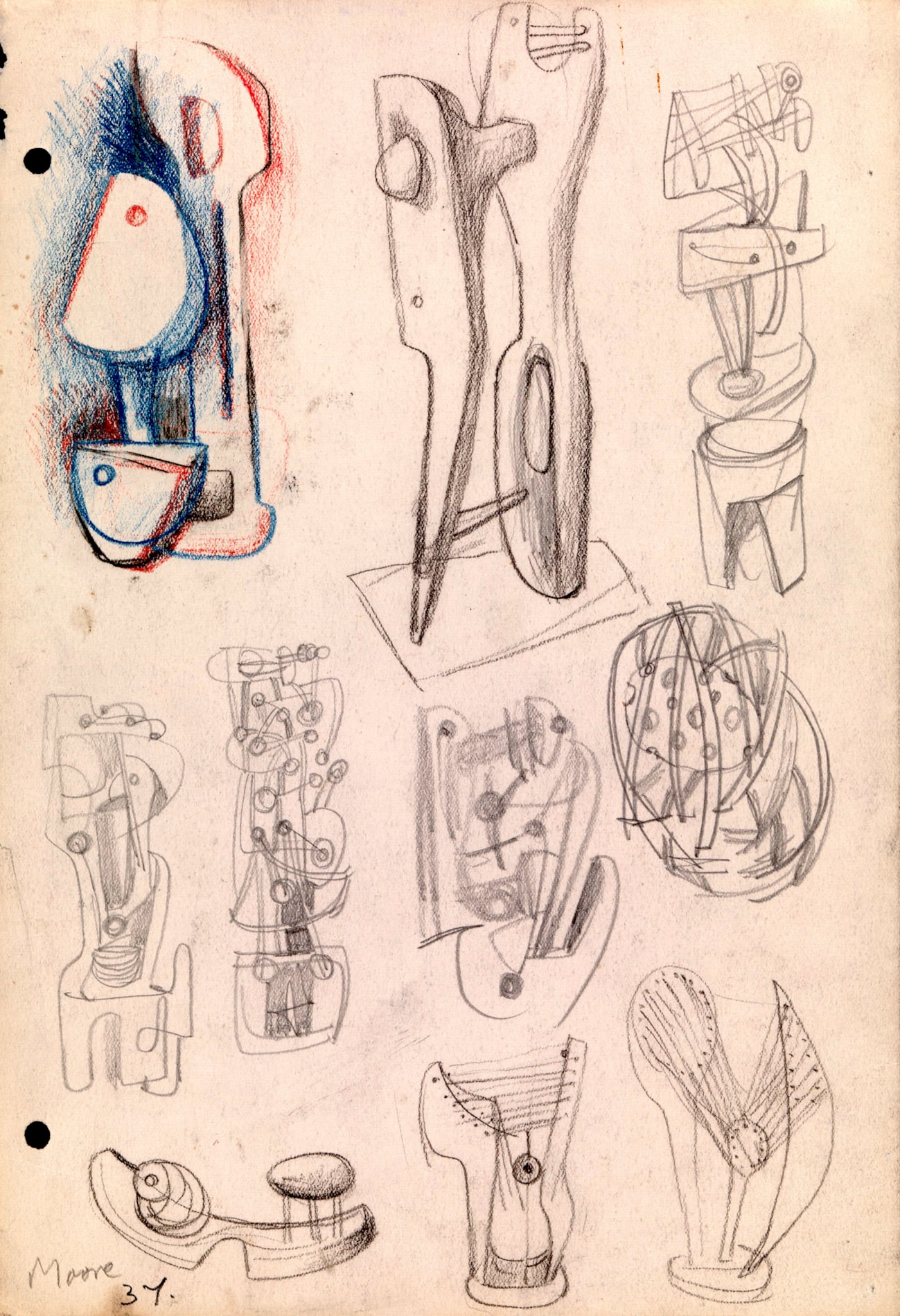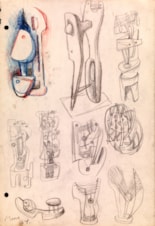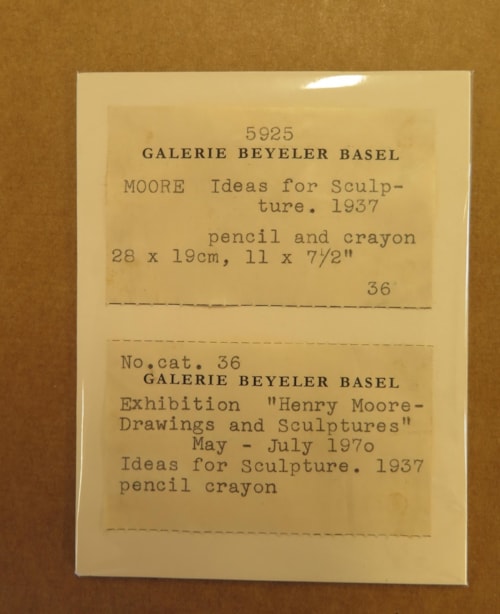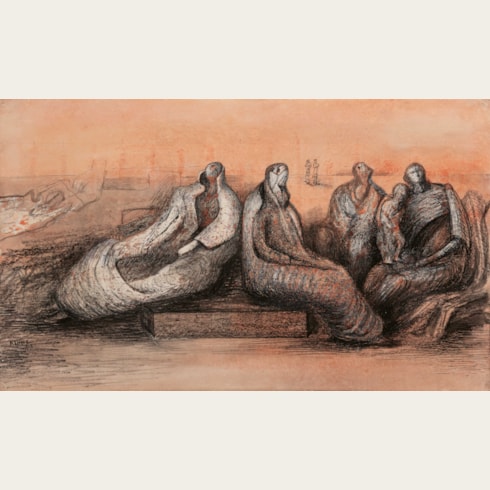Henry MOORE
(Castleford 1898 - Much Hadham 1986)
Ideas for Sculpture
Sold
Pencil and coloured crayon.
Signed and dated Moore / 37 in pencil at the lower left.
Numbered 36 and inscribed Ideas for Sculpture / 1937 / 11” x 7 1/2” / Pencil & Red & Blue crayon in pencil on the verso.
278 x 191 mm. (10 7/8 x 7 1/2 in.)
Signed and dated Moore / 37 in pencil at the lower left.
Numbered 36 and inscribed Ideas for Sculpture / 1937 / 11” x 7 1/2” / Pencil & Red & Blue crayon in pencil on the verso.
278 x 191 mm. (10 7/8 x 7 1/2 in.)
Drawn in 1937, this fascinating sheet of sketches has been characterized as containing ‘some of the most innovative designs that were never made’ by the sculptor. As with many of Moore’s drawings for sculptures, ideas and motifs in one sheet of studies are often repeated and developed in other drawings. The central form on the uppermost row in the present sheet - ‘an abstracted image of a copulating couple’, as it has been described – reappears in two other important drawings of the same date. The same form is found towards the left foreground of a large composition entitled Drawing for Metal Sculpture, in a private collection, and again at the right of the large drawing Five Figures in a Setting in the Henry Moore Family Collection. Similarly, three other elements studied in this drawing – the right-hand form in the top row, as well the second and fourth forms from the left in the middle row - are further developed in a larger and more finished Drawing for Metal Sculpture, drawn in chalk, watercolour and crayon, which was executed the following year.
Despite the wealth of sculptural ideas expressed in this drawing, none of these elements appear to have been translated into actual finished works. This is often the case with Moore’s drawings of studies for sculpture, which, as one scholar has pointed out, when taken together contained ‘[a] profusion of ideas which would require a dozen lifetimes to realise in three dimensions.’ Nevertheless, as Andrew Causey has noted of Henry Moore’s drawings of 1937 in particular, ‘at no other point in Moore’s work are there so many strange, imaginative shapes that have independent circulation in drawing without emerging into sculpture.’
In her comprehensive catalogue raisonné of Henry Moore’s drawings, the artist’s niece Ann Garrould noted of the present sheet that it is ‘the first of many drawings dated between 1937 and 1940 bearing a pair of punched holes along one edge, whose significance has not been determined; some are single pages of approximately 280 x 190 mm....others are double this size with a fold down the middle...Another group of drawings are double page in size but without the centre fold...Many of these drawings can be linked stylistically but no attempt has been made to reconstitute them as sketchbooks.’
A sheet of studies such as the present sheet provides a valuable insight into Moore’s creative process, and the way in which he developed his designs and motifs. As the sculptor once stated, ‘If an idea really means something to you, it returns and if it returns two or three times you do something about it. If you begin drawing in a sketchbook with the idea of tapping yourself for ideas, sometimes they come so many and so easily that to judge them would be silly. One must let them happen and then judge them in a week, a month, or two months and then pick out from that little set of suggestions those that still mean more than any of the others.’
Despite the wealth of sculptural ideas expressed in this drawing, none of these elements appear to have been translated into actual finished works. This is often the case with Moore’s drawings of studies for sculpture, which, as one scholar has pointed out, when taken together contained ‘[a] profusion of ideas which would require a dozen lifetimes to realise in three dimensions.’ Nevertheless, as Andrew Causey has noted of Henry Moore’s drawings of 1937 in particular, ‘at no other point in Moore’s work are there so many strange, imaginative shapes that have independent circulation in drawing without emerging into sculpture.’
In her comprehensive catalogue raisonné of Henry Moore’s drawings, the artist’s niece Ann Garrould noted of the present sheet that it is ‘the first of many drawings dated between 1937 and 1940 bearing a pair of punched holes along one edge, whose significance has not been determined; some are single pages of approximately 280 x 190 mm....others are double this size with a fold down the middle...Another group of drawings are double page in size but without the centre fold...Many of these drawings can be linked stylistically but no attempt has been made to reconstitute them as sketchbooks.’
A sheet of studies such as the present sheet provides a valuable insight into Moore’s creative process, and the way in which he developed his designs and motifs. As the sculptor once stated, ‘If an idea really means something to you, it returns and if it returns two or three times you do something about it. If you begin drawing in a sketchbook with the idea of tapping yourself for ideas, sometimes they come so many and so easily that to judge them would be silly. One must let them happen and then judge them in a week, a month, or two months and then pick out from that little set of suggestions those that still mean more than any of the others.’
Drawing was at the centre of Henry Moore’s artistic practice. Over the course of his long career, he made over seven thousand drawings, many of these as part of sketchbooks (though the artist preferred the term ‘notebooks’). Moore’s myriad drawings – studies from life, copies after the work of earlier artists, studies of objects from nature and, most significantly, studies and ideas for sculptures – seem to have always been regarded by the artist, as well as by contemporary scholars and artists, as significant works of art in their own right. They were included in exhibitions of his work from the very start of his career; indeed, his first solo exhibition, at the Warren Gallery in London in 1928, included fifty-one drawings alongside forty-two sculptures. (Several drawings from the exhibition were acquired by the curator and art historian Kenneth Clark – who was to become one of Moore’s most fervent supporters – as well as the artists Jacob Epstein, Henry Lamb and Augustus John.) Moore’s second one-man show, at the Leicester Galleries in 1931, included thirty-four sculptures and nineteen drawings. In later years, a number of gallery and museum exhibitions were devoted solely to Moore’s drawings, the first being held at the Zwemmer Gallery in London in 1935. As further evidence of his desire to have his drawings regarded as autonomous works of art, Moore often unbound his sketchbooks and sold the individual drawings to collectors.
During much of the early part of the Second World War, when commissions were few and materials for stone or wood sculpture hard to come by, Moore poured his energy into drawing. The most significant of these works, and certainly the best known, were the so-called shelter drawings, made in London in the early 1940s. Depicting people taking refuge in London Undergound stations during the nightly bombing of London during the Blitz, they were mostly drawn from memory on the basis of sketches and notes made on the spot. Moore continued to produce these shelter drawings when he left London for the village of Perry Green, near Much Hadham in Hertfordshire, when his home in Hampstead in north London was damaged during the Blitz. The shelter drawings soon came to the attention of Kenneth Clark, by then the Director of the National Gallery, as well as Surveyor of the King’s Pictures and Chairman of the War Artists Advisory Committee. Clark commissioned Moore to create a series of shelter drawings as an official War Artist, and several were exhibited at the National Gallery in London in 1941. They are today regarded as among the artist’s greatest achievements as a draughtsman.
Moore returned to sculpture in 1943, and continued to generate most of his ideas through the practice of drawing. As Andrew Causey has noted, ‘He did not use drawing to resolve parts of sculptures he planned to make: his drawings for sculptures are always of finished objects, and he rarely seems to have worked on sculptures with drawings around him, as if, once he had decided on the result he was looking for, drawing was no longer useful. To that extent drawing and sculpture were separate practices: one began where the other ended.’ In the 1950s, Moore’s growing international success, and the increasing number of commissions he received, led to a considerable decline in the amount of drawings he produced. He began to concentrate on sculpture, using drawings mainly to develop ideas for specific works rather than as a means of experimentation. (He also created designs for sculpture in the form of clay or plaster maquettes.) With the exception of the shelter drawings he produced during the Second World War, however, Moore rarely gave specific or descriptive titles to his drawings, preferring to exhibit them under generic titles such as ‘Drawings for Sculpture’, ‘Drawings for Carving’, ‘Ideas for Sculpture’, and so forth.
During much of the early part of the Second World War, when commissions were few and materials for stone or wood sculpture hard to come by, Moore poured his energy into drawing. The most significant of these works, and certainly the best known, were the so-called shelter drawings, made in London in the early 1940s. Depicting people taking refuge in London Undergound stations during the nightly bombing of London during the Blitz, they were mostly drawn from memory on the basis of sketches and notes made on the spot. Moore continued to produce these shelter drawings when he left London for the village of Perry Green, near Much Hadham in Hertfordshire, when his home in Hampstead in north London was damaged during the Blitz. The shelter drawings soon came to the attention of Kenneth Clark, by then the Director of the National Gallery, as well as Surveyor of the King’s Pictures and Chairman of the War Artists Advisory Committee. Clark commissioned Moore to create a series of shelter drawings as an official War Artist, and several were exhibited at the National Gallery in London in 1941. They are today regarded as among the artist’s greatest achievements as a draughtsman.
Moore returned to sculpture in 1943, and continued to generate most of his ideas through the practice of drawing. As Andrew Causey has noted, ‘He did not use drawing to resolve parts of sculptures he planned to make: his drawings for sculptures are always of finished objects, and he rarely seems to have worked on sculptures with drawings around him, as if, once he had decided on the result he was looking for, drawing was no longer useful. To that extent drawing and sculpture were separate practices: one began where the other ended.’ In the 1950s, Moore’s growing international success, and the increasing number of commissions he received, led to a considerable decline in the amount of drawings he produced. He began to concentrate on sculpture, using drawings mainly to develop ideas for specific works rather than as a means of experimentation. (He also created designs for sculpture in the form of clay or plaster maquettes.) With the exception of the shelter drawings he produced during the Second World War, however, Moore rarely gave specific or descriptive titles to his drawings, preferring to exhibit them under generic titles such as ‘Drawings for Sculpture’, ‘Drawings for Carving’, ‘Ideas for Sculpture’, and so forth.
Provenance
Galerie Beyeler, Basel, in 1970
Private collection, Switzerland.
Literature
Ezio Gribaudo and David Mitchinson, Henry Moore: Unpublished Drawings, Turin, 1971, no.130; David Mitchinson and Ezio Gribaudo, Henry Moore: unpublished drawings, New York, 1972, pl.130; Alan G. Wilkinson, The Drawings of Henry Moore, Ph.D thesis, London, Courtauld Institute of Art, 1974, published New York and London, 1984, p.285, under L.H. 190, illustrated pl.204; Ann Garrould, ed., Henry Moore: Complete Drawings. Vol.2: 1930-39, London, 1998, pp.194-195, no.AG 37.62 (HMF 1337); Andrew Causey, The Drawings of Henry Moore, Farnham, 2010, p.91, illustrated p.93, pl.81.
Exhibition
Basel, Galerie Beyeler, Henry Moore: Drawings Watercolours Gouaches, May-June 1970, no.36.






